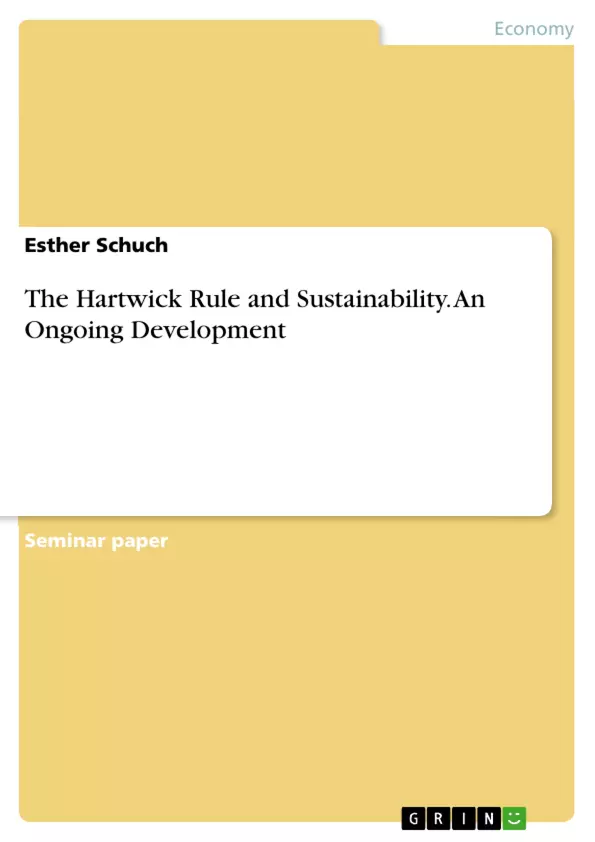"Contemplation of the world's disappearing supplies of minerals, forests, and other exhaustible assets has led to demands for regulation of their exploitation. The feeling that these products are now too cheap for the good of future generations, that they are being selfishly exploited at too rapid a rate, and that in consequence of their excessive cheapness they are being produced and consumed wastefully has given rise to the conservation movement" (Hotelling 1931, 139).
Already in 1931 Hotelling described aptly the problem concerning sustainable management of resources in order to ensure intergenerational equity. More than 80 years later the problem still has not been solved but a lot of work has been done in order to
nd a remedy. One major contributor is John Hartwick with his rule concerning how to keep consumption constant if the economy runs partially on exhaustible resources. This paper starts with a short introduction to three different concepts of sustainability. It continues to give an overview of relevant research prior to Hartwick. The main part consists of the original Hartwick rule which is discussed in some depth. In the following priority is given to adaptations to the rule done by Hartwick himself over those by other economists. Obviously, it is not possible to cover every work in this regard. Rather, the work chosen tackles those aspects that are viewed most critically and were fairly close in time to release to the original Hartwick rule.
Inhaltsverzeichnis (Table of Contents)
- Introduction
- Sustainability
- Weak Sustainability
- Strong Sustainability
- Environmental Sustainability
- The Foundations of the Hartwick Rule
- The Hartwick Rule
- The basic Model
- Extensions to the basic Model by Hartwick
- Extensions to the basic Model by other Economists
- Conclusion
- References
Zielsetzung und Themenschwerpunkte (Objectives and Key Themes)
This paper aims to provide an in-depth analysis of the Hartwick Rule, a concept developed by John Hartwick that aims to maintain constant consumption levels even when an economy relies partially on exhaustible resources. The paper starts by exploring different concepts of sustainability, then delves into the background of the Hartwick Rule, outlining its origins and key influences. The main focus is on the original Hartwick Rule and its subsequent adaptations, primarily those made by Hartwick himself and other economists. While acknowledging the extensive body of research on this topic, the paper focuses on the most critical and relevant works, particularly those released close in time to the original Hartwick Rule.
- Sustainability and its different concepts (weak, strong, and environmental)
- The Hartwick Rule and its foundations in neoclassical models
- The original Hartwick Rule and its core principles
- Extensions and adaptations to the Hartwick Rule by various economists
- The implications of the Hartwick Rule for sustainable resource management
Zusammenfassung der Kapitel (Chapter Summaries)
The introduction highlights the enduring issue of sustainable resource management, drawing on Hotelling's 1931 work, which emphasized the need for intergenerational equity. The paper then introduces the concept of sustainability, defining it as a balance between meeting present needs and preserving the ability of future generations to do the same. This section explores three major types of sustainability – weak, strong, and environmental – highlighting their differing approaches to the substitution of natural and physical capital.
Chapter 3 delves into the foundations of the Hartwick Rule, providing context by examining the contributions of key figures in resource economics. This includes Hotelling's model on the optimal rate of extraction for exhaustible resources, emphasizing the importance of ensuring that the present value of a resource remains constant over time. The chapter also explores Solow's work on infinite growth under finite resource constraints, emphasizing the role of technological progress in achieving sustainability.
Schlüsselwörter (Keywords)
This paper centers around the themes of sustainable resource management, intergenerational equity, and the concept of the Hartwick Rule. The key focus areas include neoclassical economic models, the substitutability of natural and physical capital, optimal resource extraction, and the use of mathematical models to analyze resource dynamics. This research explores key concepts like weak sustainability, the Hotelling Rule, and the role of technological progress in achieving sustainable growth.
- Quote paper
- B.A., B.Sc. Esther Schuch (Author), 2014, The Hartwick Rule and Sustainability. An Ongoing Development, Munich, GRIN Verlag, https://www.grin.com/document/273700



